An Unprecedented Tridentate-Bridging Coordination Mode of Permanganate Ions: The Synthesis of an Anionic Coordination Polymer—[CoIII(NH3)6]n[(K(κ1-Cl)2(μ2,2′,2″-(κ3-O,O′,O″-MnO4)2)n∞]—Containing Potassium Central Ion and Chlorido and Permanganato Ligands
Abstract
:1. Introduction
2. Results and Discussion
2.1. Single Crystal X-ray Studies of Compound 1
- y + 2/3, −x + y + 1/3, −z + 1/3
- −x + y, −x + 1, z
- −x + 2/3, −y + 1/3, −z + 1/3 + 1
- −x + y, −x, z
2.2. Correlation Analysis of Compound 1
2.3. Vibrational Spectroscopic Evaluation of Cation Modes in Compound 1
2.4. UV-VIS Study of Compound 1
2.5. Thermal Behavior of Compound 1
- (a)
- (b)
- the reaction of chlorine and ammonia to form HCl and N2
- (c)
- the reaction of HCl and ammonia into NH4Cl, and the dissociation of the sublimed ammonium chloride into NH3 and HCl in a vacuum, which were detected by TG-MS.
3. Materials and Methods
3.1. Single Crystal X-ray Diffraction
3.2. Hirshfeld Surface Analysis
3.3. Powder X-ray Diffraction
3.4. Vibrational Spectroscopy
3.5. UV-Vis Spectroscopy
3.6. Scanning Electron Microscopy
3.7. DSC Studies
3.8. Thermal Studies
4. Conclusions
Supplementary Materials
Author Contributions
Funding
Institutional Review Board Statement
Informed Consent Statement
Data Availability Statement
Conflicts of Interest
References
- Béres, K.A.; Homonnay, Z.; Kótai, L. Hexakis(Urea-O)Iron Complex Salts as a Versatile Material Family: Overview of Their Properties and Applications. ACS Omega 2024, 9, 11148–11167. [Google Scholar] [CrossRef] [PubMed]
- Fogaca, L.A.; Kováts, É.; Németh, G.; Kamarás, K.; Béres, K.A.; Németh, P.; Petruševski, V.; Bereczki, L.; Holló, B.B.; Sajó, I.E.; et al. Solid-Phase Quasi-Intramolecular Redox Reaction of [Ag(NH3)2]MnO4: An Easy Way to Prepare Pure AgMnO2. Inorg. Chem. 2021, 60, 3749–3760. [Google Scholar] [CrossRef] [PubMed]
- Béres, K.; Homonnay, Z.; Bereczki, L.; Dürvanger, Z.; Petruševski, V.; Farkas, A.; Kótai, L. Crystal Nanoarchitectonics and Characterization of the Octahedral Iron(III)–Nitrate Complexes with Isomer Dimethylurea Ligands. Crystals 2023, 13, 1019. [Google Scholar] [CrossRef]
- Bereczki, L.; Fogaça, L.A.; Dürvanger, Z.; Harmat, V.; Kamarás, K.; Németh, G.; Holló, B.B.; Petruševski, V.M.; Bódis, E.; Farkas, A.; et al. Dynamic Disorder in the High-Temperature Polymorph of Bis[Diamminesilver(I)] Sulfate—Reasons and Consequences of Simultaneous Ammonia Release from Two Different Polymorphs. J. Coord. Chem. 2021, 74, 2144–2162. [Google Scholar] [CrossRef]
- Béres, K.A.; Sajó, I.E.; Lendvay, G.; Trif, L.; Petruševski, V.M.; Barta-Holló, B.; Korecz, L.; Franguelli, F.P.; László, K.; Szilágyi, I.M.; et al. Solid-Phase “Self-Hydrolysis” of [Zn(NH3)4MoO4@2H2O] Involving Enclathrated Water—An Easy Route to a Layered Basic Ammonium Zinc Molybdate Coordination Polymer. Molecules 2021, 26, 4022. [Google Scholar] [CrossRef]
- Franguelli, F.P.; Béres, K.A.; Kótai, L. Pyridinesilver Tetraoxometallate Complexes: Overview of the Synthesis, Structure, and Properties of Pyridine Complexed AgXO4 (X = Cl, Mn, Re) Compounds. Inorganics 2021, 9, 79. [Google Scholar] [CrossRef]
- Kovács, G.B.; May, N.V.; Bombicz, P.A.; Klébert, S.; Németh, P.; Menyhárd, A.; Novodárszki, G.; Petrusevski, V.; Franguelli, F.P.; Magyari, J.; et al. An Unknown Component of a Selective and Mild Oxidant: Structure and Oxidative Ability of a Double Salt-Type Complex Having κ1O-Coordinated Permanganate Anions and Three- and Four-Fold Coordinated Silver Cations. RSC Advan. 2019, 9, 28387–28398. [Google Scholar] [CrossRef]
- Sajó, I.E.; Bakos, L.P.; Szilágyi, I.M.; Lendvay, G.; Magyari, J.; Mohai, M.; Szegedi, S.; Farkas, A.; Jánosity, A.; Klébert, S.; et al. Unexpected Sequential NH3/H2O Solid/Gas Phase Ligand Exchange and Quasi-Intramolecular Self-Protonation Yield [NH4Cu(OH)MoO4], a Photocatalyst Misidentified before as (NH4)2Cu(MoO4)2. Inorg. Chem. 2018, 57, 13679. [Google Scholar] [CrossRef]
- Kótai, L.; Sajó, I.; Jakab, E.; Keresztury, G.; Németh, C.; Gács, I.; Menyhárd, A.; Kristóf, J.; Hajba, L.; Petruševski, V.; et al. Studies on the Chemistry of [Cd(NH3)4](MnO4)2. A Low Temperature Synthesis Route of the CdMn2O4+x Type NOx and CH3SH Sensor Precursors. Z. Anorg. Allg. Chem. 2012, 638, 177–186. [Google Scholar] [CrossRef]
- Lazarenko, G.A.; Neokladnova, L.N.; Shablovskaya, S.F. Effect of Metals on the Thermal Decomposition of Cobalt(III) Hexaammine Complexes with a Metal-Containing Anion. Koord. Khimiya 1981, 7, 1485–1488. [Google Scholar]
- Lagunova, V.I.; Filatov, E.Y.; Plyusnin, P.E.; Korenev, S.V. In Situ and Ex Situ Studies of Tetrammineplatinum(II) Chromate Thermolysis. Russ. J. Inorg. Chem. 2020, 65, 1566–1570. [Google Scholar] [CrossRef]
- Serebrennikova, P.S.; Komarov, V.Y.; Sukhikh, A.S.; Khranenko, S.P.; Zadesenets, A.V.; Gromilov, S.A.; Yusenko, K.V. [NiEn3](MoO4)0.5(WO4)0.5 Co-Crystals as Single-Source Precursors for Ternary Refractory Ni–Mo–W Alloys. Nanomaterials 2021, 11, 3272. [Google Scholar] [CrossRef]
- Müller, T.G.; Mogk, J.; Conrad, M.; Kraus, F. Octaammine Eu II and Yb II Azides and Their Thermal Decompositions to the Nitrides. Eur. J. Inorg. Chem. 2016, 2016, 4162–4169. [Google Scholar] [CrossRef]
- Domonov, D.; Pechenyuk, S.; Semushina, Y.; Yusenko, K. Solid-State Transformations in Inner Coordination Sphere of [Co(NH3)6][Fe(C2O4)3]∙3H2O as a Route to Access Catalytically Active Co-Fe Materials. Materials 2019, 12, 221. [Google Scholar] [CrossRef]
- Yusenko, K.V.; Pechenyuk, S.I.; Vikulova, E.S.; Semushina, Y.P.; Baidina, I.A.; Filatov, E.Y. Isostructurality and Thermal Properties in the Series of Double Complex Salts [M1(NH3)6][M2(C2O4)3]·3H2O (M1 = Co, Ir, M2 = Fe, Cr). J. Truct. Chem. 2019, 60, 1062–1071. [Google Scholar] [CrossRef]
- Garkul’, I.A.; Zadesenets, A.V.; Plyusnin, P.E.; Filatov, E.Y.; Asanova, T.I.; Kozlov, D.V.; Korenev, S.V. Zinc(II) and Manganese(II) Oxalatopalladates as Precursors of Bimetallic Nanomaterials. Russ. J. Inorg. Chem. 2020, 65, 1571–1576. [Google Scholar] [CrossRef]
- Ilyushin, M.A.; Shugalei, I.V.; Tverjanovich, A.S.; Smirnov, A.V. Influence of the Mechanism of the Initial Stages of the Ligand Decomposition on the Initiating Ability of Cobalt(III) Ammine Tetrazolate Complexes. Russ. J. Gen. Chem. 2020, 90, 640–647. [Google Scholar] [CrossRef]
- Li, J.; Zhao, D.; Zhang, L.; Ren, Y.; Yue, L.; Li, Z.; Sun, S.; Luo, Y.; Chen, Q.; Li, T.; et al. Boosting Electrochemical Nitrate-to-Ammonia Conversion by Self-Supported MnCo2O4 Nanowire Array. J. Colloid Interface Sci. 2023, 629, 805–812. [Google Scholar] [CrossRef]
- Gavrikov, A.V.; Belova, E.V.; Ilyukhin, A.B.; Koroteev, P.S.; Sadovnikov, A.A. Preparation and Properties of Uncommon Cd-Mn Carboxylate Complexes—per Se and as Precursors for CdMn2O4-based Ceramics. Appl. Organomet. Chem. 2021, 35, e6190. [Google Scholar] [CrossRef]
- Packiaraj, S.; Jeyaraj, M.; Chandarasekaran, K.; Rawson, J.M.; Govindarajan, S. Simple and Facile Synthesis of Pure Nanocrystalline Spinel Cobaltite by Thermal Decomposition of Solid Solution Precursors. J. Mater. Sci. Mater. Electron. 2019, 30, 18866–18877. [Google Scholar] [CrossRef]
- Kótai, L.; Petruševski, V.M.; Bereczki, L.; Béres, K.A. Catalytic Properties of the Spinel-Like CuxMn3−xO4 Copper Manganese Oxides—An Overview. Catalysts 2023, 13, 129. [Google Scholar] [CrossRef]
- Zadesenets, A.V.; Khranenko, S.P.; Shubin, Y.V.; Baidina, I.A.; Korenev, S.V. Complex Salts [Pd(NH3)4](ReO4)2 and [Pd(NH3)4](MnO4)2: Synthesis, Structure, and Thermal Properties. Russ. J. Coord. Chem. 2006, 32, 374–379. [Google Scholar] [CrossRef]
- Lee, Y.-G.; Chiao, H.-H.; Weng, Y.-C.; Lay, C.-H. The Influence of the Cu Foam on the Electrochemical Reduction of Carbon Dioxide. Inorganics 2024, 12, 57. [Google Scholar] [CrossRef]
- Dhakal, B.; Corbin, B.A.; Sosa Parada, A.; Sakai, J.G.; Felton, E.A.; McDonald, L.T.; Gross, A.J.; Nichol, G.S.; Felton, G.A.N. Manganese(I) Diamine Electrocatalysts: Electrochemical Carbon Dioxide Reduction to Carbon Monoxide. Inorganics 2023, 11, 374. [Google Scholar] [CrossRef]
- Makuve, N.; Darkwa, J.; Mehlana, G.; Makhubela, B.C.E. Hydrogenation of Carbon Dioxide to Formate Using a Cadmium-Based Metal–Organic Framework Impregnated with Nanoparticles. Inorganics 2022, 10, 30. [Google Scholar] [CrossRef]
- Khattak, Z.A.K.; Ahmad, N.; Younus, H.A.; Ullah, H.; Yu, B.; Munawar, K.S.; Ashfaq, M.; Ali, S.; Shahadat, H.M.; Verpoort, F. Synthesis of 3D Cadmium(II)-Carboxylate Framework Having Potential for Co-Catalyst Free CO2 Fixation to Cyclic Carbonates. Inorganics 2022, 10, 162. [Google Scholar] [CrossRef]
- Freindorf, M.; Kraka, E. URVA and Local Mode Analysis of an Iridium Pincer Complex Efficiently Catalyzing the Hydrogenation of Carbon Dioxide. Inorganics 2022, 10, 234. [Google Scholar] [CrossRef]
- Tajbakhsh, E.; McKearney, D.; Leznoff, D.B.; Warren, J.J. Heterogenous Preparations of Solution-Processable Cobalt Phthalocyanines for Carbon Dioxide Reduction Electrocatalysis. Inorganics 2023, 11, 43. [Google Scholar] [CrossRef]
- Andizhanova, T.; Adilkhanova, A.; Khalimon, A. Homogeneous Metal-Catalyzed Hydrogenation of CO2 Derivatives: Towards Indirect Conversion of CO2 to Methanol. Inorganics 2023, 11, 302. [Google Scholar] [CrossRef]
- Moreno, J.; Campagnolo, L.; Boitier, B.; Nikas, A.; Koasidis, K.; Gambhir, A.; Gonzalez-Eguino, M.; Perdana, S.; Van De Ven, D.-J.; Chiodi, A.; et al. The Impacts of Decarbonization Pathways on Sustainable Development Goals in the European Union. Commun. Earth Environ. 2024, 5, 136–150. [Google Scholar] [CrossRef]
- Das, S.; Yadav, G.D. Tailored Design of Novel Co0-Coδ+ Dual Phase Nanoparticles for Selective CO2 Hydrogenation to Ethanol. J. Environ. Sci. 2025, 149, 598–615. [Google Scholar] [CrossRef] [PubMed]
- Huang, X.; Sun, H.; He, X.; Ruan, Y.; Gan, L. Construction of a Metal–Oxide Interface through Alloy Nanoparticles to Enhance CO2 Electrolysis. New J. Chem. 2024, 48, 2140–2145. [Google Scholar] [CrossRef]
- Xiong, B.; Liu, J.; Yang, Y.; Ding, J.; Hua, Z. Tunable Cu–M Bimetal Catalysts Enable Syngas Electrosynthesis from Carbon Dioxide. New J. Chem. 2022, 46, 1203–1209. [Google Scholar] [CrossRef]
- Kim, O.A.; Bogdan, T.V.; Koklin, A.E.; Bogdan, V.I. Interaction of Carbon Dioxide with Hydrogen on Supported Fe,Cr-Containing Catalysts. Russ. J. Phys. Chem. B 2022, 16, 1218–1220. [Google Scholar] [CrossRef]
- Mansouri, M.; Atashi, H.; Tabrizi, F.F.; Mirzaei, A.A.; Mansouri, G. Kinetics Studies of Nano-Structured Cobalt–Manganese Oxide Catalysts in Fischer–Tropsch Synthesis. J. Ind. Eng. Chem. 2013, 19, 1177–1183. [Google Scholar] [CrossRef]
- Mansouri, G.; Mohsen, M. Synthesis and Characterization of Co-Mn Nanocatalyst Prepared by Thermal Decomposition for Fischer-Tropsch Reaction. Iran. J. Chem. Chem. Eng. 2018, 38, 1. [Google Scholar]
- Béres, K.A.; Szilágyi, F.; Homonnay, Z.; Dürvanger, Z.; Bereczki, L.; Trif, L.; Petruševski, V.M.; Farkas, A.; Bayat, N.; Kótai, L. Structural, Spectroscopic, and Thermal Decomposition Features of [Carbonatotetraamminecobalt(III)] Iodide—Insight into the Simultaneous Solid-Phase Quasi-Intramolecular Redox Reactions. Inorganics 2023, 11, 68. [Google Scholar] [CrossRef]
- Barta, H.; Bayat, N.; Bereczki, L.; Petrusevski, V.; Béres, K.; Farkas, A.; Szilágyi, I.; Kótai, L. Spectroscopic and Structural Characterization of Hexaamminecobalt(III) Dibromide Permanganate. J. Serb. Chem. Soc. 2023, 88, 1237–1252. [Google Scholar] [CrossRef]
- Zakeri, M.; Samimi, A.; Khorram, M.; Atashi, H.; Mirzaei, A. Effect of Forming on Selectivity and Attrition of Co-Precipitated Co–Mn Fischer–Tropsch Catalysts. Powder Technol. 2010, 200, 164–170. [Google Scholar] [CrossRef]
- Khassin, A.A.; Sipatrov, A.G.; Demeshkina, M.P.; Minyukova, T.P. Partially Hydrated Iron–Chromium Oxide Catalyst for the Fischer-Tropsch Synthesis. React. Kinet. Catal. Lett. 2009, 97, 371–379. [Google Scholar] [CrossRef]
- Franguelli, F.P.; Kováts, É.; Czégény, Z.; Bereczki, L.; Petruševski, V.M.; Barta Holló, B.; Béres, K.A.; Farkas, A.; Szilágyi, I.M.; Kótai, L. Multi-Centered Solid-Phase Quasi-Intramolecular Redox Reactions of [(Chlorido)Pentaamminecobalt(III)] Permanganate—An Easy Route to Prepare Phase Pure CoMn2O4 Spinel. Inorganics 2022, 10, 18. [Google Scholar] [CrossRef]
- Bereczki, L.; Petruševski, V.M.; Franguelli, F.P.; Béres, K.A.; Farkas, A.; Holló, B.B.; Czégény, Z.; Szilágyi, I.M.; Kótai, L. [Hexaamminecobalt(III)] Dichloride Permanganate—Structural Features and Heat-Induced Transformations into (CoII,MnII)(CoIII,MnIII)2O4 Spinels. Inorganics 2022, 10, 252. [Google Scholar] [CrossRef]
- Yang, X.-Z.; Hongtao, Z.; Huo, C.; Liu, H.-Z. Application of Fused Iron Catalysts Fe-M (M=V, Cr, Mn) in Fischer-Tropsch Synthesis. J. Chem. Eng. Chin. Univ. 2018, 32, 1359–1364. [Google Scholar] [CrossRef]
- Luo, J.; Zhu, X.; Zhong, Z.; Chen, G.; Hong, Y.; Zhou, Z. Enhanced Catalytic Soot Oxidation over Co-Based Metal Oxides: Effects of Transition Metal Doping. Molecules 2023, 29, 41. [Google Scholar] [CrossRef]
- Bae, J.; Shin, D.; Jeong, H.; Choe, C.; Choi, Y.; Han, J.W.; Lee, H. Facet-Dependent Mn Doping on Shaped Co3O4 Crystals for Catalytic Oxidation. ACS Catal. 2021, 11, 11066–11074. [Google Scholar] [CrossRef]
- Park, J.E.; Park, E.D. Effects of Surface Area of Co–Mn–O Catalysts on the Selective CO Oxidation in H2. Catal. Lett. 2014, 144, 607–614. [Google Scholar] [CrossRef]
- Solt, H.E.; Németh, P.; Mohai, M.; Sajó, I.E.; Klébert, S.; Franguelli, F.P.; Fogaca, L.A.; Pawar, R.P.; Kótai, L. Temperature-Limited Synthesis of Copper Manganites along the Borderline of the Amorphous/Crystalline State and Their Catalytic Activity in CO Oxidation. ACS Omega 2021, 6, 1523–1533. [Google Scholar] [CrossRef]
- Bulavchenko, O.A.; Afonasenko, T.N.; Sigaeva, S.S.; Ivanchikova, A.V.; Saraev, A.A.; Gerasimov, E.Y.; Kaichev, V.V.; Tsybulya, S.V. The Structure of Mixed Mn–Co Oxide Catalysts for CO Oxidation. Top. Catal. 2020, 63, 75–85. [Google Scholar] [CrossRef]
- Zhao, Z.; Lin, J.; Wang, G.; Muhammad, T. Novel Co-Mn-O Nanosheet Catalyst for CO Preferential Oxidation toward Hydrogen Purification. AIChE J. 2015, 61, 239–252. [Google Scholar] [CrossRef]
- More, R.; More, P. Highly Facile Co2+ and Mn3+ Species Supported on Hydroxyapatite Catalyst for Carbon Monoxide Oxidation at a Lower Temperature. Bull. Mater. Sci. 2022, 45, 111–121. [Google Scholar] [CrossRef]
- Zhao, H.; Wang, H.; Qu, Z. Synergistic Effects in Mn-Co Mixed Oxide Supported on Cordierite Honeycomb for Catalytic Deep Oxidation of VOCs. J. Environ. Sci. 2022, 112, 231–243. [Google Scholar] [CrossRef]
- Sui, C.; Zeng, S.; Ma, X.; Zhang, Y.; Zhang, J.; Xie, X. Research Progress of Catalytic Oxidation of Volatile Organic Compounds over Mn-Based Catalysts—A Review. Rev. Inorg. Chem. 2023, 43, 1–12. [Google Scholar] [CrossRef]
- Zhou, H.; Su, W.; Xing, Y.; Wang, J.; Zhang, W.; Jia, H.; Su, W.; Yue, T. Progress of Catalytic Oxidation of VOCs by Manganese-Based Catalysts. Fuel 2024, 366, 131305. [Google Scholar] [CrossRef]
- Cui, Y.; Zeng, Z.; Hou, Y.; Ma, S.; Shen, W.; Huang, Z. A Low-Noble-Metal Ru@CoMn2O4 Spinel Catalyst for the Efficient Oxidation of Propane. Molecules 2024, 29, 2255. [Google Scholar] [CrossRef]
- Mu, G.; Xie, H.; Jian, Y.; Jiang, Z.; Li, L.; Tian, M.; Zhang, L.; Wang, J.; Chai, S.; He, C. Facile Construction and Enhanced Catalytic Activity of Co-Mn Oxide with Rich Amorphous/Crystalline Interfaces for Propane Oxidation. Sep. Purif. Technol. 2024, 348, 127699. [Google Scholar] [CrossRef]
- Zhu, Z.-J.; He, Z.-H.; Wang, S.-W.; Wu, B.-T.; Tian, Y.; Sun, Y.-C.; Wang, K.; Wang, W.; Wang, H.; Liu, Z.-T. Photothermal Catalytic CO2 Oxidative Dehydrogenation of Propane over Co-Mn Bimetallic Oxides Supported on MCM-41 Molecular Sieve. J. Mol. Cat. 2024, 559, 114070. [Google Scholar] [CrossRef]
- Wang, Y.; Chen, W.; Zhong, Y.; Zhong, N.; Huang, K. A Study of Microwave-Enhanced Catalytic Degradation of Benzene Using Co-Mn Metal Oxides Combined with Numerical Simulation. Chem. Eng. Process. 2023, 189, 109403. [Google Scholar] [CrossRef]
- Huang, R.; Luo, L.; Hu, W.; Tang, Z.; Ji, X.; Chen, L.; Yu, Z.; Zhang, Y.; Zhang, D.; Xiao, P. Insight into the pH Effect on the Oxygen Species and Mn Chemical Valence of Co–Mn Catalysts for Total Toluene Oxidation. Catal. Sci. Technol. 2022, 12, 4157–4168. [Google Scholar] [CrossRef]
- Rastegarpanah, A.; Deng, J.; Liu, Y.; Jing, L.; Pei, W.; Wang, J.; Dai, H. Bamboo-like MnO2·Co3O4: High-Performance Catalysts for the Oxidative Removal of Toluene. J. Environ. Sci. 2025, 147, 617–629. [Google Scholar] [CrossRef]
- Xie, C.; Li, L.; Zhai, X.; Chu, W. Improved Redox Synthesis of Mn–Co Bimetallic Oxide Catalysts Using Citric Acid and Their Toluene Oxidation Activity. RSC Adv. 2023, 13, 11069–11080. [Google Scholar] [CrossRef]
- Huang, Y.; Ye, K.; Li, H.; Fan, W.; Zhao, F.; Zhang, Y.; Ji, H. A Highly Durable Catalyst Based on CoxMn3–xO4 Nanosheets for Low-Temperature Formaldehyde Oxidation. Nano Res. 2016, 9, 3881–3892. [Google Scholar] [CrossRef]
- Wang, J.; Zhang, C.; Yang, S.; Liang, H.; Men, Y. Highly Improved Acetone Oxidation Activity over Mesoporous Hollow Nanospherical MnxCo3−xO4 Solid Solutions. Catal. Sci. Technol. 2019, 9, 6379–6390. [Google Scholar] [CrossRef]
- Saheli, S.; Rezvani, A.R.; Arabshahi, A.; Dusek, M.; Samolova, E.; Jarosova, M. Synthesis New Co–Mn Mixed Oxide Catalyst for the Production of Light Olefins by Tuning the Catalyst Structure. Appl. Organomet. Chem. 2021, 35, e6038. [Google Scholar] [CrossRef]
- Liu, J.; Zhang, Y.; Yan, X.; Wang, Z.; Wu, F.; Fang, S.; Jian, P. Selective Oxidation of o-chlorotoluene to o-chlorobenzaldehyde Catalyzed by (Co,Mn)(Co,Mn)2O4 Catalysts. Can. J. Chem. Eng. 2018, 96, 1746–1751. [Google Scholar] [CrossRef]
- Wu, M.; Zhan, W.; Guo, Y.; Guo, Y.; Wang, Y.; Wang, L.; Lu, G. An Effective Mn-Co Mixed Oxide Catalyst for the Solvent-Free Selective Oxidation of Cyclohexane with Molecular Oxygen. Appl. Catal. A Gen. 2016, 523, 97–106. [Google Scholar] [CrossRef]
- Yang, F.; Ding, Y.; Tang, J.; Zhou, S.; Wang, B.; Kong, Y. Oriented Surface Decoration of (Co-Mn) Bimetal Oxides on Nanospherical Porous Silica and Synergetic Effect in Biomass-Derived 5-Hydroxymethylfurfural Oxidation. Mol. Catal. 2017, 435, 144–155. [Google Scholar] [CrossRef]
- Rao, K.T.V.; Rogers, J.L.; Souzanchi, S.; Dessbesell, L.; Ray, M.B.; Xu, C. (Charles) Inexpensive but Highly Efficient Co–Mn Mixed-Oxide Catalysts for Selective Oxidation of 5-Hydroxymethylfurfural to 2,5-Furandicarboxylic Acid. ChemSusChem 2018, 11, 3323–3334. [Google Scholar] [CrossRef]
- Sun, M.; Tang, S.-N.; Chen, Z.-X.; Zhai, L.-F.; Xia, Y.; Wang, S. Mn-Doping-Induced Co 3 O 4 Structural Distortion and Facet Change for Enhanced Electro-Activation of O2 toward Pollutants Removal. ACS EST. Eng. 2024, 4, 1970–1980. [Google Scholar] [CrossRef]
- Tao, L.; Zhao, G.; Chen, P.; Zhang, Z.; Liu, Y.; Lu, Y. High-Performance Co-MnOx Composite Oxide Catalyst Structured onto Al-Fiber Felt for High-Throughput O3 Decomposition. ChemCatChem 2019, 11, 1131–1142. [Google Scholar] [CrossRef]
- Zhang, W.; Li, F.; Zhang, P.; Zhang, W.; Liu, S.; Lv, C.; Li, K. Coeffect of Co-Mn in Bimetallic Oxide Catalyst for Ultrafast Electrochemical Reduction of Nitrate: Insight into Ion Interaction. Sep. Purif. Technol. 2024, 328, 124962. [Google Scholar] [CrossRef]
- Wang, W.; Liu, E.; Hu, Y.; Jiao, L.; Kolla, P.; Liu, Y.; Tang, M.; Luo, J.; Sun, Q.; Chen, S.; et al. Understanding the ORR Electrocatalysis on Co–Mn Oxides. J. Phys. Chem. C 2021, 125, 25470–25477. [Google Scholar] [CrossRef]
- Strekalova, S.; Khrizanforov, M.; Budnikova, Y. Evaluation of Transition Metal Catalysts in Electrochemically Induced Aromatic Phosphonation. Molecules 2019, 24, 1823. [Google Scholar] [CrossRef]
- Yang, Y.; Peng, H.; Xiong, Y.; Li, Q.; Lu, J.; Xiao, L.; DiSalvo, F.J.; Zhuang, L.; Abruña, H.D. High-Loading Composition-Tolerant Co–Mn Spinel Oxides with Performance beyond 1 W/Cm2 in Alkaline Polymer Electrolyte Fuel Cells. ACS Energy Lett. 2019, 4, 1251–1257. [Google Scholar] [CrossRef]
- Xu, H.; Wei, J.; Zhang, K.; Zhang, M.; Liu, C.; Guo, J.; Du, Y. Constructing Bundle-like Co-Mn Oxides and Co-Mn Selenides for Efficient Overall Water Splitting. J. Mater. Chem. A 2018, 6, 22697–22704. [Google Scholar] [CrossRef]
- Jiang, Z.-R.; Wang, P.; Zhou, Y.-X.; Wang, C.; Jiang, J.; Lan, Y.; Chen, C. Fabrication of a 3D-Blocky Catalyst (CoMnOx@sponge) via Mooring Co-Mn Bimetallic Oxide on Sponge to Activate Peroxymonosulfate for Convenient and Efficient Degradation of Sulfonamide Antibiotics. J. Chem. Eng. 2022, 446, 137306. [Google Scholar] [CrossRef]
- Liangdy, A.; Lee, W.J.; Tonanon, P.; Webster, R.D.; Snyder, S.A.; Lim, T.-T. Unravelling the Synergism of Catalytic Oxidation and Filtration in Co-Mn-Oxide Impregnated Ceramic Membrane for Intensified Degradation of Recalcitrant Micropollutant with Peroxymonosulfate. J. Chem. Eng. 2023, 454, 140075. [Google Scholar] [CrossRef]
- Guo, Z.; Li, C.; Gao, M.; Han, X.; Zhang, Y.; Zhang, W.; Li, W. Mn−O Covalency Governs the Intrinsic Activity of Co-Mn Spinel Oxides for Boosted Peroxymonosulfate Activation. Angew. Chem. Int. Ed. 2021, 60, 274–280. [Google Scholar] [CrossRef]
- Cheng, X.; Wang, X.; Ma, C.; Wang, J.; Qiao, W.; Ling, L. Facile Synthesis of Schistose-like Co-Mn Oxides for Low-Temperature Catalytic Oxidation of NO with Enhanced SO2/H2O Tolerance. J. Environ. Chem. Eng. 2022, 10, 108457. [Google Scholar] [CrossRef]
- Baran, E.J.; Aymonino, P.J. Über Hexamminkobalt(III)-permanganat. Z. Anorg. Allg. Chem. 1968, 362, 215–219. [Google Scholar] [CrossRef]
- Henrici-Olivé, G.; Olivé, S. The Role of Alkali Promoters in the Fischer—Tropsch Synthesis. J. Mol. Catal. 1982, 16, 187–193. [Google Scholar] [CrossRef]
- Gaube, J.; Klein, H.-F. The Promoter Effect of Alkali in Fischer-Tropsch Iron and Cobalt Catalysts. Appl. Catal. A Gen. 2008, 350, 126–132. [Google Scholar] [CrossRef]
- Li, Z.; Yao, N.; Cen, J.; Li, X.; Zhong, L.; Sun, Y.; He, M. Effects of Alkali Metal Promoters on the Structure–Performance Relationship of CoMn Catalysts for Fischer–Tropsch Synthesis. Catal. Sci. Technol. 2020, 10, 1816–1826. [Google Scholar] [CrossRef]
- Klobb, T. De Quelques Permanganates Nouveaux. Bull. Soc. Chim. 1887, 47, 240–244. [Google Scholar]
- Klobb, T. Contribution à l’étude Des Sels Lutéocobaltiques. Bull. Soc. Chim. Paris 1901, 25, 1022–1031. [Google Scholar]
- Song, X.-M.; Huang, X.-Q.; Dou, J.-M.; Li, D.-C. Catena-Poly[[(18-Crown-6)Potassium(I)]-μ-Chlorido-Silver(I)-μ-Chlorido]. Acta Crystallogr. Sect. E Struct. Rep. Online 2007, 63, m2219. [Google Scholar] [CrossRef]
- Jentzsch, A.V.; Emery, D.; Mareda, J.; Nayak, S.K.; Metrangolo, P.; Resnati, G.; Sakai, N.; Matile, S. Transmembrane Anion Transport Mediated by Halogen-Bond Donors. Nat. Commun. 2012, 3, 905–913. [Google Scholar] [CrossRef]
- Homborg, H. Die Feinstruktur in Den Schwingungs- und Elektronischen Absorptionsspektren von [CrO4]2− und [MnO4]−. Z. Anorg. Allg. Chem. 1983, 498, 25–40. [Google Scholar] [CrossRef]
- Müller, A.; Krebs, B. IR-Spektren Kristalliner, Wasserfreier Permanganate, Pertechnetate Und Perrhenate. Z. Naturforschung B 1966, 21, 3–7. [Google Scholar] [CrossRef]
- Clark, R.J.H.; Cobbold, D.G.; Stewart, B. Resonance Raman Excitation Profiles for the Totally Symmetric Mode of the Permanganate Ion. Chem. Phys. Lett. 1980, 69, 488–490. [Google Scholar] [CrossRef]
- Clark, R.J.H.; Dines, T.J. Resonance Raman Spectrum of the Permanganate Ion in Different Host Lattices. J. Chem. Soc. Faraday Trans. 2 1982, 78, 723. [Google Scholar] [CrossRef]
- Kiefer, W.; Bernstein, H.J. The Resonance Raman Effect of the Permanganate and Chromate Ions. Mol. Phys. 1972, 23, 835–851. [Google Scholar] [CrossRef]
- Ferraro, J.R. Low-Frequency Vibrations of Inorganic and Coordination Compounds; Springer: Boston, MA, USA, 1971; ISBN 978-1-4684-1811-8. [Google Scholar]
- Sacconi, L.; Sabatini, A.; Gans, P. Infrared Spectra from 80 to 2000 cm−1 of Some Metal-Ammine Complexes. Inorg. Chem. 1964, 3, 1772–1774. [Google Scholar] [CrossRef]
- Müller, A.; Böschen, I.; Baran, E.J. Über Hexamminmetallchalkogenometallate. Monatsh. Chem. 1973, 104, 821–835. [Google Scholar] [CrossRef]
- Grinberg, A.A.; Varshavskii, Y.S. The Frequency of Coordinated Ammonia Deformation Mode and Its Relationship with the Chemical Properties of Transition Metal Ammonia Complexes. In Primenenie Molekulyarnoi Spektroskopii v Khimii; Khimiya: Moscow, Russia, 1966; pp. 104–107. [Google Scholar]
- Hendry, P.; Ludi, A. Structure, Reactivity, Spectra, and Redox Properties of Cobalt(III) Hexaamines. Adv. Inorg. Chem. 1990, 35, 117–198. [Google Scholar] [CrossRef]
- Mitsutsuka, Y.; Kondo, I.; Nakahara, M. Splitting Parameters in Ligand Field Absorption Bands of Cobalt(III) Ammine Complexes with Chloro or Aqua Ligands. Bull. Chem. Soc. Jpn. 1986, 59, 2767–2771. [Google Scholar] [CrossRef]
- Sakiyama, H.; Ishiyama, Y.; Sugawara, H. Trigonally-Compressed Octahedral Geometry of Hexaamminecobalt(III) Complex Cation in Aqueous Solution Investigated from the Electronic Spectra. Spectrosc. Lett. 2017, 50, 111–114. [Google Scholar] [CrossRef]
- Wilson, R.B.; Solomon, E.I. Spectroscopic Studies of the Photoactive 4T2g Excited State of Hexaamminechromium(III). Inorg. Chem. 1978, 17, 1729–1736. [Google Scholar] [CrossRef]
- Wilson, R.B.; Solomon, E.I. Spectroscopic Studies of Photochemically Important Transition Metal Excited States. 2. The 1T1g, 3T1g, and 5T2g Excited States of Hexaamminecobalt(III). J. Am. Chem. Soc. 1980, 102, 4085–4095. [Google Scholar] [CrossRef]
- Benedix, R.; Hennig, H.; Nieke, C. NDDO/CI Calculations of the Electronic Spectra of Cobalt(III) Ammine Complexes. Inorganica Chim. Acta 1990, 172, 109–112. [Google Scholar] [CrossRef]
- Mehrotra, R.N. Review on the Chemistry of [M(NH3)n](XO4)m (M = Transition Metal, X = Mn, Tc or Re, n = 1–6, m = 1–3) Ammine Complexes. Inorganics 2023, 11, 308. [Google Scholar] [CrossRef]
- Béres, K.A.; Homonnay, Z.; Barta Holló, B.; Gracheva, M.; Petruševski, V.M.; Farkas, A.; Dürvanger, Z.; Kótai, L. Synthesis, Structure, and Mössbauer Spectroscopic Studies on the Heat-Induced Solid-Phase Redox Reactions of Hexakis(Urea-O)Iron(III) Peroxodisulfate. J. Mater. Res. 2023, 38, 1102–1118. [Google Scholar] [CrossRef]
- Simmons, E.L.; Wendlandt, W.W. The Thermal Decomposition of Metal Complexes—XVIII Intermediates Formed in the Decomposition of Hexamminecobalt (III) Chloride. J. Inorg. Nucl. Chem. 1966, 28, 2187–2191. [Google Scholar] [CrossRef]
- Jörgensen, S.M. VIII. Ueber Die Luteokobaltsalze. J. Prakt. Chem. 1887, 35, 417. [Google Scholar] [CrossRef]
- Rigaku. CrystalClear SM; Rigaku Corporation: Tokyo, Japan, 2008. [Google Scholar]
- Spek, A.L. Single-Crystal Structure Validation with the Program PLATON. J. Appl. Crystallogr. 2003, 36, 7–13. [Google Scholar] [CrossRef]
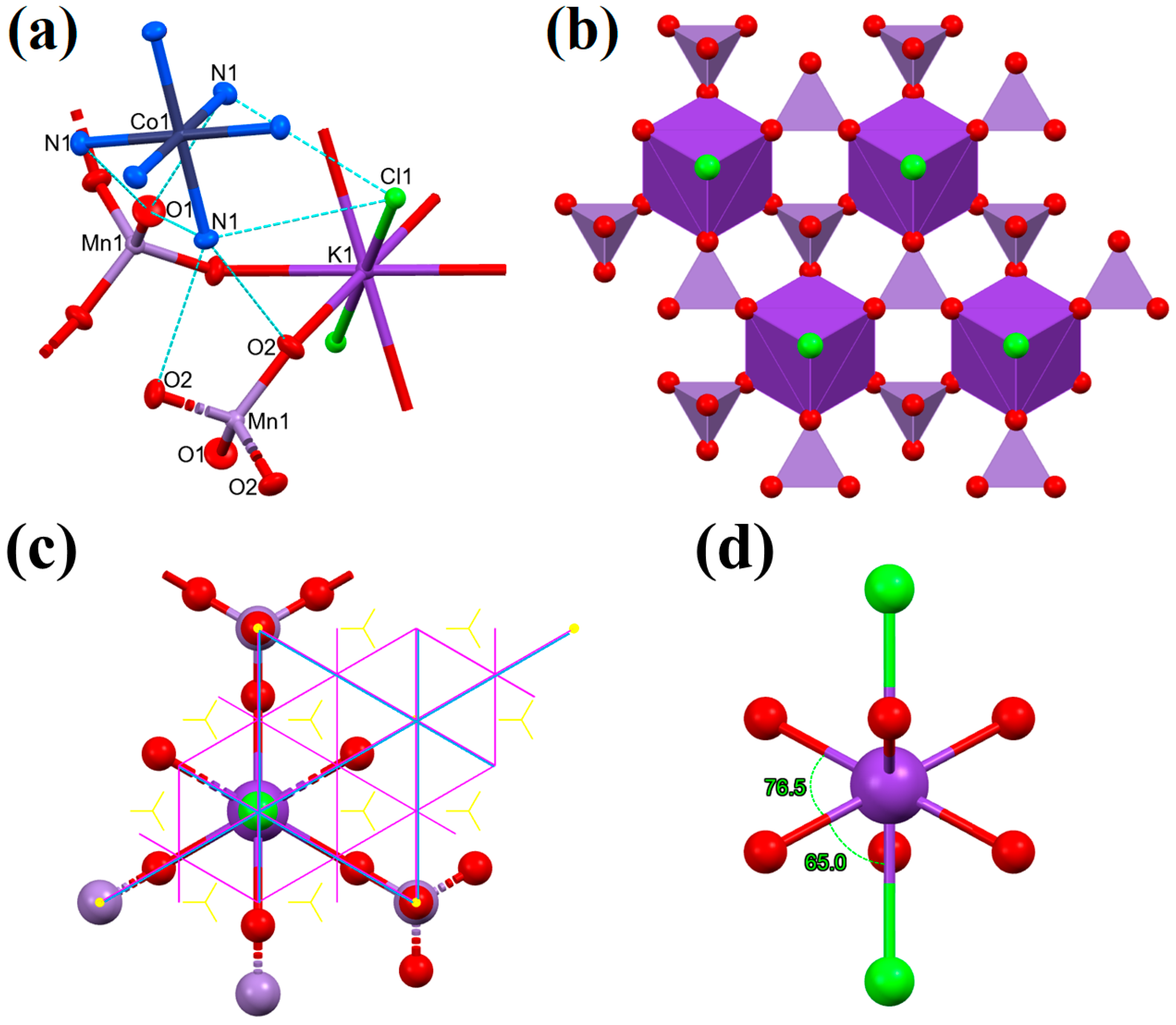


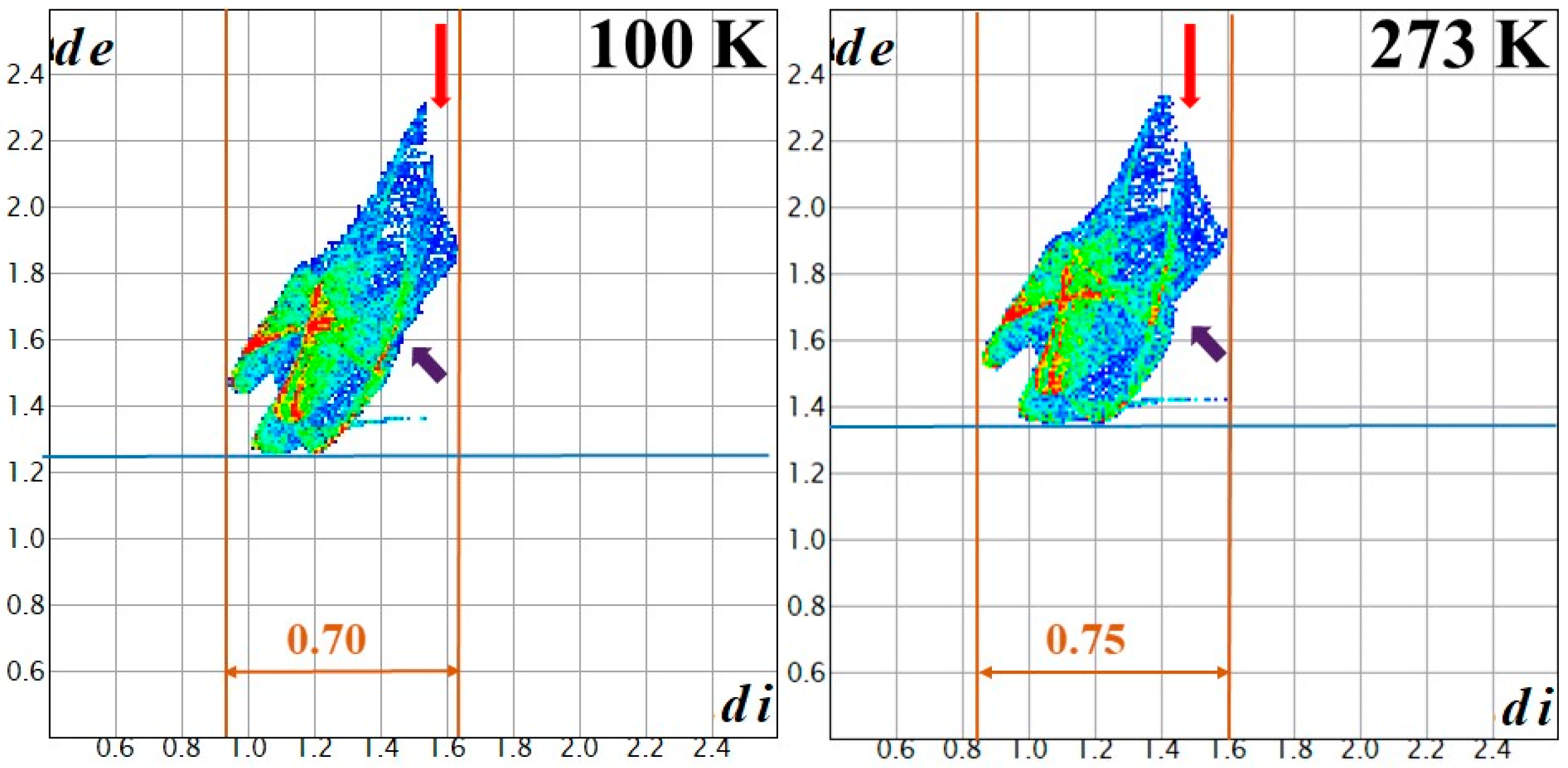
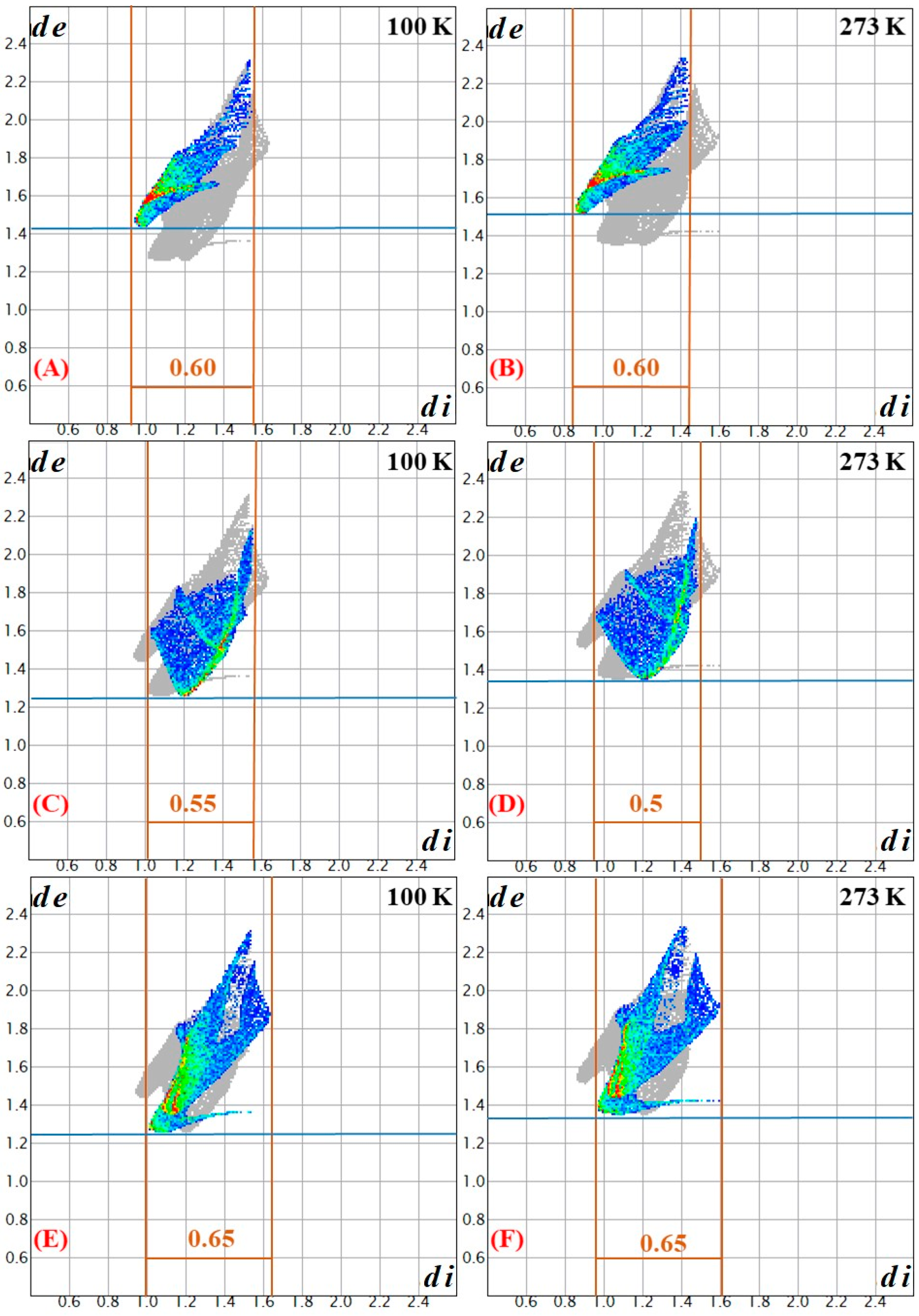
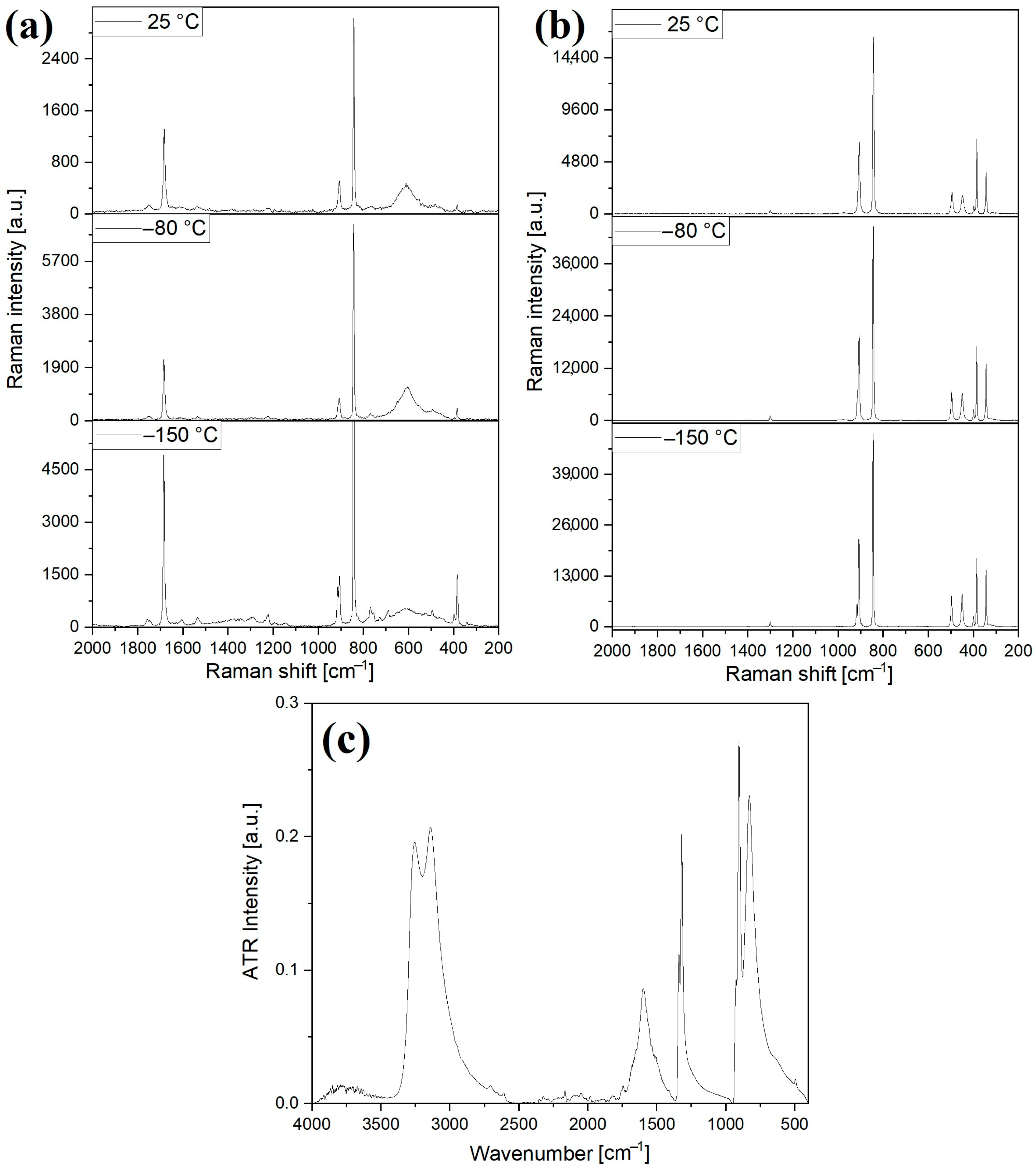

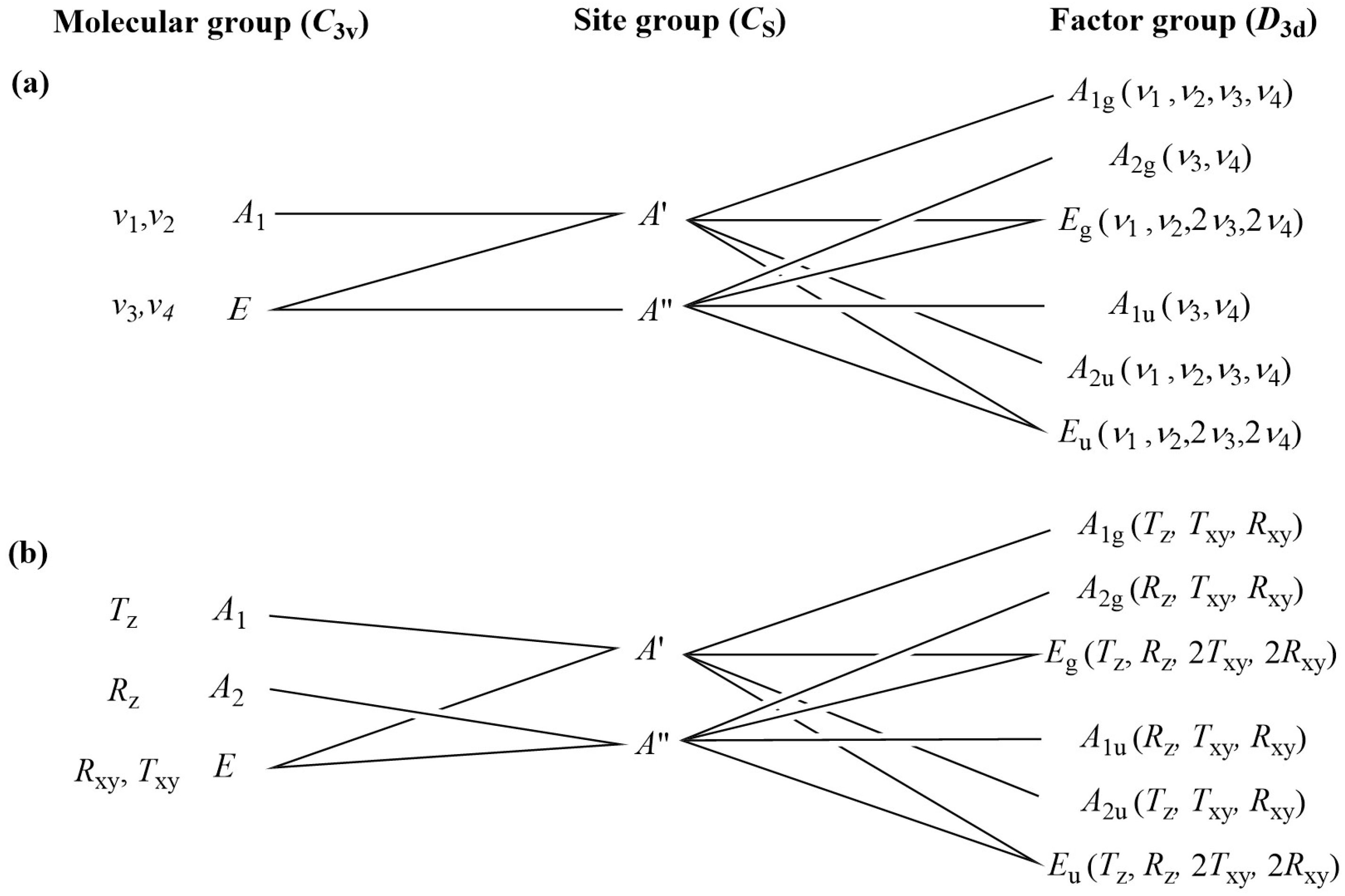
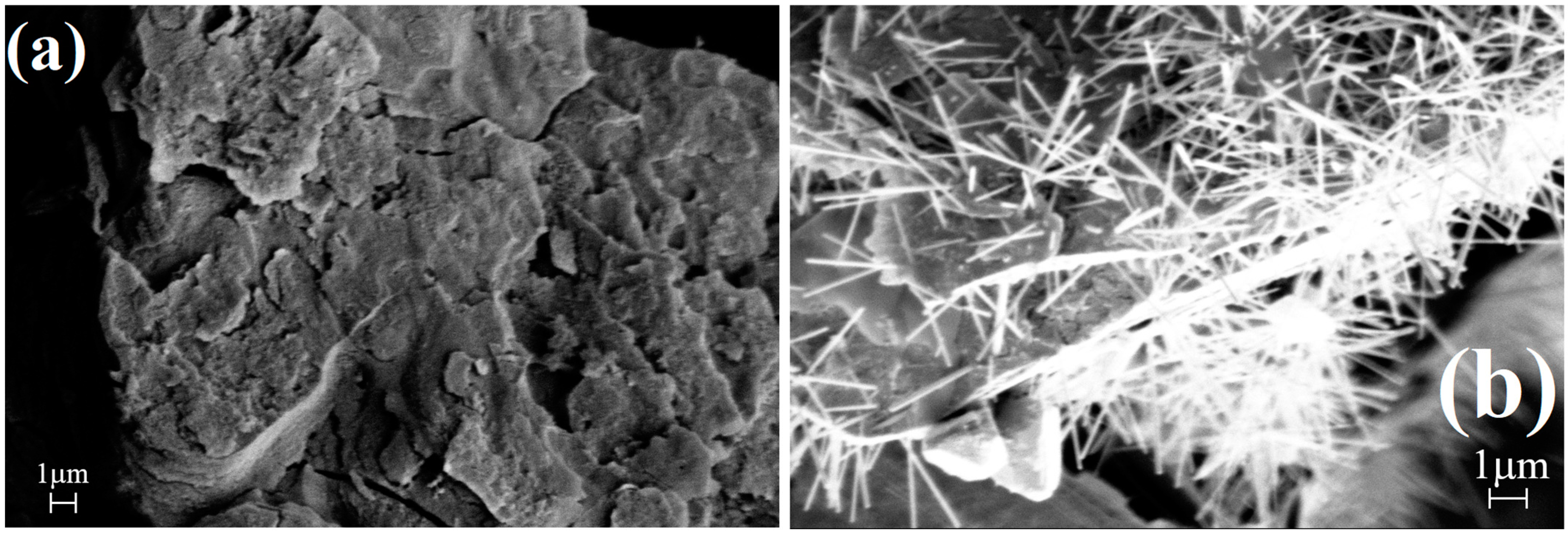
| Empirical formula | Cl6Co3H54K3Mn6N18O24 | |
| Formula weight | 1527.04 | |
| Temperature (K) | 100 (2) | 273 (2) |
| Radiation and wavelength (Å) | Mo-Kα, λ = 0.71073 | Cu-Kα, λ = 1.54178 |
| Crystal system | Trigonal | |
| Space group | R—3m | |
| Unit cell dimensions (Å) | a = 6.9642 (8) | a = 6.9969 (4) |
| c = 27.6254 (18) | c = 27.7558 (12) | |
| Volume (Å3) | 1160.3 (3) | 1176.78 (7) |
| Z | 1 | |
| Density (calculated, Mg/m3) | 2.185 | 2.155 |
| Absorption coefficient, μ (mm−1) | 3.321 | 27.013 |
| F(000) | 762 | 762 |
| Crystal colour | Violet | |
| Crystal description | Platelet | |
| Crystal size (mm) | 0.64 × 0.60 × 0.07 | 0.33 × 0.28 × 0.17 |
| Absorption correction | numerical | multi-scan |
| Max. and min. transmission | 0.689/0.953 | 0.152/1.000 |
| Θ-range for data collection | 3.458 ≤ Θ ≤ 30.499° | 4.780 ≤ Θ ≤ 68.131° |
| Index ranges | −9 ≤ h ≤ 9; −9 ≤ k ≤ 9; −39 ≤ l ≤ 39 | −7 ≤ h ≤ 8; −8 ≤ k ≤ 8; −33 ≤ l ≤ 33 |
| Reflections collected | 18,492 | 13,017 |
| Completeness to 2Θ | 0.997 | 1.000 |
| Friedel coverage | 0.000 | 0.000 |
| Independent reflections | 489 [R(int) = 0.0619] | 311 [R(int) = 0.1299] |
| Reflections I > 2σ(I) | 489 | 305 |
| Refinement method | full-matrix least-squares on F2 | full-matrix least-squares on F2 |
| Data/restraints/parameters | 489/0/27 | 311/0/26 |
| Goodness-of-fit on F2 | 1.452 | 1.249 |
| Final R indices [I > 2σ(I)] | R1 = 0.0322, wR2 = 0.0798 | R1 = 0.0585, wR2 = 0.1510 |
| R indices (all data) | R1 = 0.0322, wR2 = 0.0798 | R1 = 0.0593, wR2 = 0.1520 |
| Max. and mean shift/esd | 0.000; 0.000 | 0.000; 0.000 |
| Largest diff. peak and hole (e·Å−3) | 0.700; −0.935 | 1.057; −2.305 |
| Bond Lengths | 100 K | 273 K |
|---|---|---|
| Mn1—O1 | 1.604(4) | 1.590(6) |
| Mn1—O2 | 1.614(2) | 1.606(4) |
| Co1—N1 | 1.959(2) | 1.950(4) |
| K1—O2 | 2.763(2) | 2.791(4) |
| K1—Cl1 | 3.433(1) | 3.471(2) |
| Bond Angles | 100 K | 273 K |
| O1—Mn1—O2 | 110.09(8) | 110.2(1) |
| O2—Mn1—O2 | 108.85(8) | 108.7(2) |
| Mn1—O2—K1 | 134.9(1) | 135.0(2) |
| O2#1—K1—O2#2 | 76.59(5) | 76.40(9) |
| O2#2—K1—Cl1#3 | 64.99(4) | 65.15(8) |
| Torsion Angle | 100 K | 273 K |
| O2#4—Mn1—O2-K1 | 120.8(1) | 120.9(2) |
| Nr | Donor--H⸱⸱⸱Acceptor | Symm. Op. | D⸱⸱⸱A, Å | ||
|---|---|---|---|---|---|
| 100 K | 273 K | Δ(A)/Δ(%) | |||
| 1 | N1—H1A⸱⸱⸱Cl1 | y, x, −z | 3.318(3) | 3.336(5) | 0.018/0.54 |
| 2 | N1—H1B⸱⸱⸱O1 | x, y, z | 2.976(4) | 2.997(6) | 0.022/0.74 |
| 3 | N1—H1B⸱⸱⸱O2 | 2/3 − x, 1/3 − x + y, 1/3 − z | 3.138(3) | 3.164(6) | 0.025/0.80 |
| 4 | N1—H1C⸱⸱⸱Cl1 | x, −1 + y, z | 3.506(2) | 3.524(4) | 0.018/0.51 |
| 5 | N1—H1C⸱⸱⸱O2 | 2/3 + x − y, 1/3 − y, 1/3 − z | 3.138(4) | 3.164(7) | 0.025/0.80 |
| Band/Assignation | Compound 1 | ||
|---|---|---|---|
| IR Wavenumber, cm−1 | Raman Shift (748 nm Excitation), cm−1, −130 °C | Raman Shift (532 nm Excitation), cm−1, −130 °C | |
| ν1(MnO4), νs(A) | 830 * | 845 | 842 |
| ν2(MnO4), δs(E) | 359 | 343 | --- |
| ν3(MnO4), νas(F2) | 925, 904 | 919, 907 | 914, 906 |
| ν4(MnO4), δas(F2) | 395 | 400, 385 | 398, 383 |
| Mode | IR Wavenumber, cm−1 | Raman Shifts, 785 nm Excitation, −130 °C |
|---|---|---|
| ν1(CoN6)νs | - | 497 * |
| ν2(CoN6)νas | - | 450 |
| ν3(CoN6)νs | 503 | - |
| ν4(CoN6)δas | 318 | - |
| ν5(CoN6)δs | - | not detectable |
| ν6(CoN6)δ | - | - |
| Assignment in O Symmetry | Compound 1 | [Co(NH3)6]Cl2MnO4 [42] | [Co(NH3)6]Cl3 [101] |
|---|---|---|---|
| 1A1→3T1 | Out of measurement range | 830 | 833 |
| 1A1→5T2 | 708sh | 727 | 730 |
| 1A1→3T2 | 602sh | - | 617 |
| 568 * | 575sh | 581 | |
| 1A1→1T1 | 485sh | 490 | 486 |
| 455sh, 432 | 450 | 444 | |
| 1A1→1T2 | 391 | 375 | 367 |
| 345, 326sh | 343, 330sh | 324 |
Disclaimer/Publisher’s Note: The statements, opinions and data contained in all publications are solely those of the individual author(s) and contributor(s) and not of MDPI and/or the editor(s). MDPI and/or the editor(s) disclaim responsibility for any injury to people or property resulting from any ideas, methods, instructions or products referred to in the content. |
© 2024 by the authors. Licensee MDPI, Basel, Switzerland. This article is an open access article distributed under the terms and conditions of the Creative Commons Attribution (CC BY) license (https://creativecommons.org/licenses/by/4.0/).
Share and Cite
Kótai, L.; Béres, K.A.; Farkas, A.; Holló, B.B.; Petruševski, V.M.; Homonnay, Z.; Trif, L.; Franguelli, F.P.; Bereczki, L. An Unprecedented Tridentate-Bridging Coordination Mode of Permanganate Ions: The Synthesis of an Anionic Coordination Polymer—[CoIII(NH3)6]n[(K(κ1-Cl)2(μ2,2′,2″-(κ3-O,O′,O″-MnO4)2)n∞]—Containing Potassium Central Ion and Chlorido and Permanganato Ligands. Molecules 2024, 29, 4443. https://doi.org/10.3390/molecules29184443
Kótai L, Béres KA, Farkas A, Holló BB, Petruševski VM, Homonnay Z, Trif L, Franguelli FP, Bereczki L. An Unprecedented Tridentate-Bridging Coordination Mode of Permanganate Ions: The Synthesis of an Anionic Coordination Polymer—[CoIII(NH3)6]n[(K(κ1-Cl)2(μ2,2′,2″-(κ3-O,O′,O″-MnO4)2)n∞]—Containing Potassium Central Ion and Chlorido and Permanganato Ligands. Molecules. 2024; 29(18):4443. https://doi.org/10.3390/molecules29184443
Chicago/Turabian StyleKótai, László, Kende Attila Béres, Attila Farkas, Berta Barta Holló, Vladimir M. Petruševski, Zoltán Homonnay, László Trif, Fernanda Paiva Franguelli, and Laura Bereczki. 2024. "An Unprecedented Tridentate-Bridging Coordination Mode of Permanganate Ions: The Synthesis of an Anionic Coordination Polymer—[CoIII(NH3)6]n[(K(κ1-Cl)2(μ2,2′,2″-(κ3-O,O′,O″-MnO4)2)n∞]—Containing Potassium Central Ion and Chlorido and Permanganato Ligands" Molecules 29, no. 18: 4443. https://doi.org/10.3390/molecules29184443








